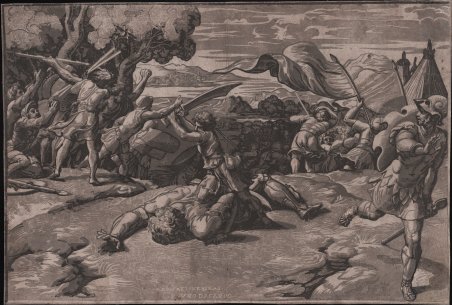Xilografia a chiaroscuro da 3 blocchi, grigio, grigio scuro e nero, circa 1520/27, da un soggetto di Raffaello Sanzio. Esemplare del secondo stato di cinque con le iscrizioni "RAPHAEL VRBINAS" e "P. VGO DACARPO" intagliate dal legno di tono chiaro nell'immagine. Magnifica prova del raro secondo stato, ricca di toni, impressa su carta vergata coeva con filigrana “sirena nel cerchio”, rifilata alla linea marginale, antichi restauri perfettamente eseguiti agli angoli di destra, tracce di piega centrale verticale, per il resto in ottimo stato di conservazione. Questa stampa si basa sull'incisione di Marcantonio Raimondi (B.XIV.12.10) che a sua volta replica un disegno di Raffaello. “Davide e Golia ritrae il giovane pastore israelita Davide, con la spada alzata, in procinto di decapitare il gigante filisteo Golia, che ha abbattuto con un colpo di fionda. Intorno a queste figure centrali, le truppe israelite e filistee ingaggiano un combattimento. Il chiaroscuro è inverso rispetto all'incisione di Marcantonio Raimondi, che con ogni probabilità è stata la fonte diretta di Ugo. L'incisione di Marcantonio si riferisce al disegno dell'affresco di Raffaello nella Loggia Vaticana. La xilografia chiaroscurale a tre blocchi di Ugo rimase in circolazione abbastanza a lungo perché i blocchi subissero cinque cambi di stato e alla fine accumulassero notevoli danni da tarlo. Nel raro primo stato, i nomi del disegnatore “RAPHAEL VRBINAS” e dello stampatore e editore “P VGO DA CARPI” sono incisi nel blocco di tonalità chiara, rispettivamente in alto e in basso nel perimetro che incornicia la composizione. Nel secondo stato, entrambi i nomi appaiono insieme all'interno dell'immagine, in primo piano in basso al centro del legno di tonalità chiara, e il perimetro del legno viene tagliato. Tra il secondo e il terzo stato, le lance impugnate da un combattente in alto a sinistra sono state modificate con un tassello inserito nel blocco più scuro. Il nome di Ugo viene eliminato dal legno di tono nel quarto stato, mentre il nome di Raffaello viene rimosso nel quinto e ultimo. Probabilmente gli stati quattro e cinque devono essere stati stampati dopo la morte di Ugo, poiché le prove sono eccessivamente inchiostrate e di colore atipico”. (cfr. N. Takahatake, The chiaroscuro woodcut in Renaissance Italy pp. 93-94). Bibliografia Bartsch A., Le peintre graveur, Vienna, 1803-1821, v. XII, p. 26, n. 8; Chiaroscuro woodcuts from the Frits Lugt Collection in Paris, Tokyo, 2005, pp. 39–40, n. 13 (Hinterding E.); Takahatake N., Niccolò Vicentino's Miraculous Draught of Fishes, in “Print Quarterly”, London, 2011, XVIII, 2011, 3, pp. 256-260, p. 260, n. 24; Takahatake N., Raphael and the chiaroscuro woodcut, in “Raffael als Zeichner. Die Beiträge des Frankfurter Kolloquiums”, 2015, pp. 167-186, pp. 167-168; Takahatake N., The Chiaroscuro Woodcut in Renaissance Italy, Los Angeles, 2018, pp. 93-94, n. 19; Takahatake N., Atlante delle xilografie italiane del Rinascimento, ALU.0945.1. Chiaroscuro woodcut from 3 blocks, gray, dark gray and black, circa 1520/27, after Raphael. Example of the second state of five with the inscriptions “RAPHAEL VRBINAS” and “P. VGO DACARPO” cut from the light tone block in the image. Magnificent proof of this rare second state, richly toned, printed on contemporary laid paper with "mermaid in circle" watermark, trimmed at marginal line, old perfectly executed restorations at right corners, traces of central vertical crease, otherwise in excellent condition. This print is based on the engraving by Marcantonio Raimondi (B.XIV.12.10) which in turn is based on a drawing by Raphael. “David and Goliath, captures the young Israelite shepherd David, with sword raised, about to behead the Philistine giant Goliath, who he has felled with a shot from his sling. Around these central figures, the Israelite and Philistine troops engage in combat. The chiaroscuro is in reverse of Marcantonio Raimondi's engraving, which in all likelihood served as Ugo's direct source. Marcantonio's engraving relates to Raphael's fresco design in the Vatican Loggia. Ugo's three-block chiaroscuro woodcut remained in circulation long enough for the blocks to undergo five state changes and eventually accumulate considerable insect damage. In the rare first state, the names of the designer “RAPHAEL VRBINAS” and printmaker/publisher “P VGO DA CARPI” are cut in the light tone block, respectively in the top and bottom of the perimeter that frames the composition. In the second state, both names appear together within the image in the bottom center foreground of the light tone block, and the tone block perimeter is cut back. Between the second and third states, the spears held by a combatant at upper left were modified with a plug inserted into the darkest block. Ugo's name is excised from the tone block in the fourth state, while Raphael's name is also removed in the fifth (states four and five must have been printed at a remove from Ugo, for the blocks are overly inked, the inks are inconsistently applied, and the ink palettes and formulation are atypical” (cf. N. Takahatake, The chiaroscuro woodcut in Renaissance Italy pp. 93-94). Bibliografia Bartsch A., Le peintre graveur, Vienna, 1803-1821, v. XII, p. 26, n. 8; Chiaroscuro woodcuts from the Frits Lugt Collection in Paris, Tokyo, 2005, pp. 39–40, n. 13 (Hinterding E.); Takahatake N., Niccolò Vicentino's Miraculous Draught of Fishes, in “Print Quarterly”, London, 2011, XVIII, 2011, 3, pp. 256-260, p. 260, n. 24; Takahatake N., Raphael and the chiaroscuro woodcut, in “Raffael als Zeichner. Die Beiträge des Frankfurter Kolloquiums”, 2015, pp. 167-186, pp. 167-168; Takahatake N., The Chiaroscuro Woodcut in Renaissance Italy, Los Angeles, 2018, pp. 93-94, n. 19; Takahatake N., Atlante delle xilografie italiane del Rinascimento, ALU.0945.1. ' Cfr.

Descubre cómo utilizar
Descubre cómo utilizar

